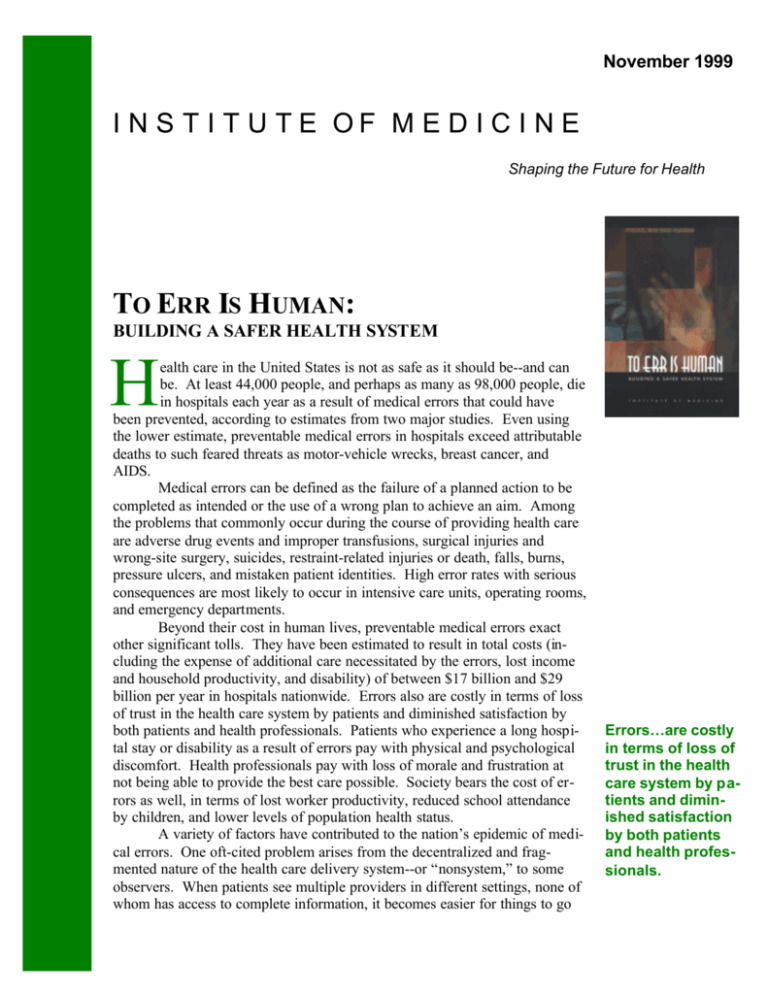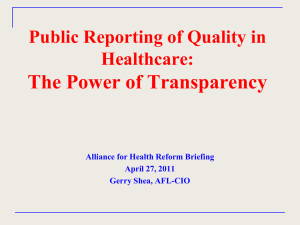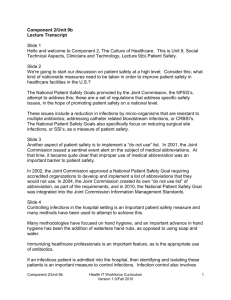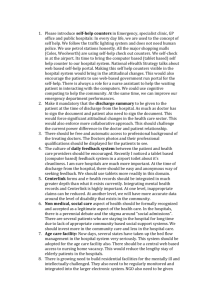
November 1999
I N S T I T U TE OF M E D I C I N E
Shaping the Future for Health
TO ERR IS HUMAN:
BUILDING A SAFER HEALTH SYSTEM
H
ealth care in the United States is not as safe as it should be--and can
be. At least 44,000 people, and perhaps as many as 98,000 people, die
in hospitals each year as a result of medical errors that could have
been prevented, according to estimates from two major studies. Even using
the lower estimate, preventable medical errors in hospitals exceed attributable
deaths to such feared threats as motor-vehicle wrecks, breast cancer, and
AIDS.
Medical errors can be defined as the failure of a planned action to be
completed as intended or the use of a wrong plan to achieve an aim. Among
the problems that commonly occur during the course of providing health care
are adverse drug events and improper transfusions, surgical injuries and
wrong-site surgery, suicides, restraint-related injuries or death, falls, burns,
pressure ulcers, and mistaken patient identities. High error rates with serious
consequences are most likely to occur in intensive care units, operating rooms,
and emergency departments.
Beyond their cost in human lives, preventable medical errors exact
other significant tolls. They have been estimated to result in total costs (in­
cluding the expense of additional care necessitated by the errors, lost income
and household productivity, and disability) of between $17 billion and $29
billion per year in hospitals nationwide. Errors also are costly in terms of loss
of trust in the health care system by patients and diminished satisfaction by
both patients and health professionals. Patients who experience a long hospi­
tal stay or disability as a result of errors pay with physical and psychological
discomfort. Health professionals pay with loss of morale and frustration at
not being able to provide the best care possible. Society bears the cost of er­
rors as well, in terms of lost worker productivity, reduced school attendance
by children, and lower levels of population health status.
A variety of factors have contributed to the nation’s epidemic of medi­
cal errors. One oft-cited problem arises from the decentralized and frag­
mented nature of the health care delivery system--or “nonsystem,” to some
observers. When patients see multiple providers in different settings, none of
whom has access to complete information, it becomes easier for things to go
Errors…are costly
in terms of loss of
trust in the health
care system by pa­
tients and dimin­
ished satisfaction
by both patients
and health profes­
sionals.
Types of Errors
Diagnostic
Error or delay in diagnosis
Failure to employ indicated tests
Use of outmoded tests or therapy
Failure to act on results of monitoring or testing
Treatment
Error in the performance of an operation, procedure, or test
Error in administering the treatment
Error in the dose or method of using a drug
Avoidable delay in treatment or in responding to an abnormal test
Inappropriate (not indicated) care
Preventive
Failure to provide prophylactic treatment
Inadequate monitoring or follow-up of treatment
Other
Failure of communication
Equipment failure
Other system failure
Health Care System at Odds with Itself
The Quality of Health Care in America
Committee of the Institute of Medicine
(IOM) concluded that it is not acceptable
for patients to be harmed by the health
care system that is supposed to offer healing and comfort--a system that promises,
“First, do no harm.” Helping to remedy this problem is the goal of To Err is Hu­
man: Building a Safer Health System, the IOM Committee’s first report.
In this report, issued in November 1999, the committee lays out a compre­
hensive strategy by which government, health care providers, industry, and con­
sumers can reduce preventable medical errors. Concluding that the know-how
already exists to prevent many of these mistakes, the report sets as a minimum
goal a 50 percent reduction in errors over the next five years. In its recommenda­
tions for reaching this goal, the committee strikes a balance between regulatory
and market-based initiatives, and between the roles of professionals and organi­
zations.
One of the report’s main conclusions is that the majority of medical er­
rors do not result from individual recklessness or the actions of a particular
group--this is not a “bad apple” problem. More commonly, errors are caused by
faulty systems, processes, and conditions that lead people to make mistakes or
fail to prevent them. For example, stocking patient-care units in hospitals with
certain full-strength drugs, even though they are toxic unless diluted, has re­
sulted in deadly mistakes.
Thus, mistakes can best be prevented by designing the health system at all
levels to make it safer--to make it harder for people to do something wrong and
easier for them to do it right. Of course, this does not mean that individuals can
be careless. People still must be vigilant and held responsible for their actions.
But when an error occurs, blaming an individual does little to make the system
safer and prevent someone else from committing the same error.
SOURCE: Leape, Lucian; Lawthers, Ann G.; Brennan, Troyen A., et al. Pr eventing Medical Injury. Qual Rev Bull. 19(5):144–149, 1993.
More commonly,
errors are caused
by faulty systems,
processes, and
conditions that
lead people to
make mistakes or
fail to prevent
them.
wrong. In addition, the processes by
which health professionals are licensed
and accredited have focused only limited
attention on the prevention of medical er­
rors, and even these minimal efforts have
confronted resistance from some health
care organizations and providers. Many
providers also perceive the medical liabil­
ity system as a serious impediment to sys­
tematic efforts to uncover and learn from
errors. Exacerbating these problems, most
third-party purchasers of health care provide little financial incentive for health
care organizations and providers to im­
prove safety and qua lity.
2
Strategy for Improvement
To achieve a better safety record, the report recommends a four-tiered approach:
• Establishing a national focus to create leadership, research, tools,
and protocols to enhance the knowledge base about safety.
Health care is a decade or more behind many other high-risk industries in
its attention to ensuring basic safety. This is due, in part, to the lack of a single
designated government agency devoted to improving and monitoring safety
throughout the health care delivery system. Therefore, Congress should create a
Center for Patient Safety that would set national safety goals and track progress in
meeting them; develop a research agenda; define prototype safety systems; de­
velop, disseminate, and evaluate tools for identifying and analyzing errors; de­
velop methods for educating consumers about patient safety; and recommend ad­
ditional improvements as needed.
Funding for the center should be adequate and secure, starting with $30
million to $35 million per year and growing over time to at least $100 million an­
nually--modest investments relative to the consequences of errors and to the resources devoted to other public safety issues. The center should be housed within
the Agency for Healthcare Research and Quality (AHRQ), which already is in­
volved in a broad range of quality and safety issues, and has established the infra­
structure and experience to fund research, education, and coordinating activities.
• Identifying and learning from errors by developing a nationwide
public mandatory reporting system and by encouraging health care organi­
zations and practitioners to develop and participate in voluntary reporting
systems.
Under the mandatory reporting system, state governments will be required
to collect standardized information about adverse medical events that result in
death and serious harm. Hospitals should be required to begin reporting first, and
eventually reporting should be required by all health care organizations. This
system will ensure a response to specific reports of serious injury, hold health care
organizations and providers accountable for maintaining safety, provide incen­
tives to organizations to implement internal safety systems that reduce the likeli­
hood of errors occurring, and respond to the public’s right to know about patient
safety. Currently, about a third of the states have mandatory reporting require­
ments.
Voluntary reporting systems will provide an important complement to the
mandatory system. Such systems can focus on a much broader set of errors,
mainly those that do no or minimal harm, and help detect system weaknesses that
can be fixed before the occurrence of serious harm, thereby providing rich info r­
mation to health care organizations in support of their quality improvement ef­
forts. To foster participation in voluntary systems, Congress should enact laws to
protect the confidentiality of certain information collected. Without such legisla­
tion, health care organizations and providers may be discouraged from partic i­
pating in voluntary reporting systems out of worry that the information they provide might ultimately be subpoenaed and used in lawsuits.
3
Health care is a
decade or more behind many other
high-risk industries
in its attention to
ensuring basic
safety.
Voluntary reporting
systems will provide an important
complement to the
mandatory system.
• Raising performance standards and expectations for improve­
ments in safety through the actions of oversight organizations, professional
groups, and group purchasers of health care.
The process of de­
Setting and enforcing explicit performance standards for patient safety
veloping and
through regulatory and related mechanisms, such as licensing, certification, and
adopting standards accreditation, can define minimum performance levels for health professionals,
also helps to form
the organizations in which they work, and the tools (drugs and devices) they use
expectations for
to care for patients. The process of developing and adopting standards also helps
safety among pro­
to form expectations for safety among providers and consumers.
viders and con­
Standards and expectations are not only set through regulations, however.
sumers.
The values and norms set by the health professions influence the practice, train­
ing, and education for providers. Thus, professional societies should become
leaders in encouraging and demanding improvements in patient safety, by such
actions as setting their own performance standards, convening and communicat­
ing with members about safety, incorporating attention to patient safety in training
programs, and collaborating across disciplines.
The actions of large purchasers of health care and health care insurance, as
well as actions by individual consumers, also can affect the behaviors of health
care organizations. Public and private purchasers, such as businesses buying in­
surance for their employees, must make safety a prime concern in their contract­
ing decisions. Doing so will create financial incentives for health care organiza­
tions and providers to make needed changes to ensure patient safety.
Medication errors
now occur fre­
quently in hospi­
tals, yet many hos­
pitals are not mak­
ing use of known
systems for im­
proving safety…
• Implementing safety systems in health care organizations to ensure safe practices at the delivery level.
Health care organizations must develop a “culture of safety” such that
their workforce and processes are focused on improving the reliability and safety
of care for patients. Safety should be an explicit organizational goal that is dem­
onstrated by strong leadership on the part of clinicians, executives, and governing
bodies. This will mean incorporating a variety of well-understood safety princ i­
ples, such as designing jobs and working conditions for safety; standardizing and
simplifying equipment, supplies, and processes; and enabling care providers to
avoid reliance on memory. Systems for continuously monitoring patient safety
also must be created and adequately funded.
The medication process provides an example where implementing better
systems will yield better human performance. Medication errors now occur fre­
quently in hospitals, yet many hospitals are not making use of known systems for
improving safety, such as automated medication order entry systems, nor are they
actively exploring new safety systems. Patients themselves also could provide a
major safety check in most hospitals, clinics, and practice. They should know
which medications they are taking, their appearance, and their side effects, and
they should notify their doctors of medication discrepancies and the occurrence of
side effects.
4
Progress Under Way
The response to the IOM report was swift and positive, within both government
and the private sector.
Almost immediately, the Clinton administration issued an executive order
instructing government agencies that conduct or oversee health-care programs to
implement proven techniques for reducing medical errors, and creating a task
force to find new strategies for reducing errors. Congress soon launched a series
of hearings on patient safety, and in December 2000 it appropriated $50 million to
the Agency for Healthcare Research and Quality to support a variety of efforts
targeted at reducing medical errors.
The AHRQ already has made major progress in developing and imple­
menting an action plan. Efforts under way include:
• Developing and testing new technologies to reduce medical errors.
• Conducting large-scale demonstration projects to test safety interve n­
tions and error-reporting strategies.
• Supporting new and established multidisciplinary teams of researchers
and health-care facilities and organizations, located in geographically diverse locations, that will further determine the causes of medical errors and develop new
knowledge that will aid the work of the demonstration projects.
• Supporting projects aimed at achieving a better understanding of how
the environment in which care is provided affects the ability of providers to im­
prove safety.
• Funding researchers and organizations to develop, demonstrate, and
evaluate new approaches to improving provider education in order to reduce er­
rors.
Casting its net even more broadly, the AHRQ has produced a booklet of
practical tips on what individual consumers can do to improve the quality of
health-care services they receive. The booklet focuses on key choices that indi­
viduals and their families face, such as choosing doctors, hospitals, and treat­
ments, and it stresses the importance of individuals taking an active role in se­
lecting and evaluating their care. (The booklet is available on the organization’s
Web site at www.ahrq.gov.)
In efforts focused at the state level, during the past year the National
Academy for State Health Policy (NASHP) convened leaders from both the ex­
ecutive and legislative branches of the states to discuss approaches to improving
patient safety. The NASHP also helped lead an initiative to better understand
how states with mandatory hospital error-reporting requirements administer and
enforce their programs. (A report on this initiative is available on the organiza­
tion’s Web site at www.nashp.org). In addition, the Agency for Healthcare Research and Quality has contracted with the National Quality Forum to produce a
list of so-called “never events” that states might use as the basis of a mandatory
reporting system.
Among activities in the private sector, the Leapfrog Group, an association
of private and public sector group purchasers, unveiled a market-based strategy to
improve safety and quality, including encouraging the use of computerized phys i5
cian-order entry, evidence-based hospital referrals, and the use of ICUs staffed by
physicians credentialed in critical care medicine.
Professional groups within the health-care community also have been ac­
tive. As but one example, the Council on Graduate Medical Education (COGME)
and the National Advisory Council on Nurse Education and Practice (NACNEP)
held a joint meeting on “Collaborative Education Models to Ensure Patient
Safety.” Participants addressed such issues as the effect of the relationships between physicians and nurses on patient safety, the impact of physician-nurse col­
laboration on systems designed to protect patient safety, and educational programs to ensure interdisciplinary collaboration to further patient safety. (A report
on the meeting is available on the COGME’s Web site at www.cogme.org.)
Pulling Together
With adequate
leadership, atten­
tion, and resources,
improvements can
be made.
Although no single activity can offer a total solution for dealing with medical er­
rors, the combination of activities proposed in To Err is Human offers a roadmap
toward a safer health system. With adequate leadership, attention, and resources,
improvements can be made. It may be part of human nature to err, but it is also
part of human nature to create solutions, find better alternatives, and meet the
challenges ahead.
For More Information…
Copies of To Err is Human: Building a Safer Health System are available for
sale from the National Academy Press; call (800) 624-6242 or (202) 334-3313 (in
the Washington metropolitan area), or visit the NAP home page at www.nap.edu.
The full text of this report is available at
http://www.nap.edu/books/0309068371/html/
Support for this project was provided by The National Research Council and The
Commonwealth Fund. The views presented in this report are those of the Institute
of Medicine Committee on the Quality of Health Care in America and are not
necessarily those of the funding agencies.
The Institute of Medicine is a private, nonprofit organization that provides health
policy advice under a congressional charter granted to the National Academy of
Sciences. For more information about the Institute of Medicine, visit the IOM
home page at www.iom.edu.
Copyright ©2000 by the National Academy of Sciences. All rights reserved.
Permission is granted to reproduce this document in its entirety, with no additions
or alterations
� � �
6
COMMITTEE ON QUALITY OF HEALTH CARE IN AMERICA
WILLIAM C. RICHARDSON (Chair), President and CEO, W.K. Kellogg
Foundation, Battle Creek, MI
DONALD M. BERWICK, President and CEO, Institute for Healthcare
Improvement, Boston
J. CRIS BISGARD, Director, Health Services, Delta Air Lines, Inc., Atlanta
LONNIE R. BRISTOW, Past President, American Medical Association, Walnut
Creek, CA
CHARLES R. BUCK, Program Leader, Health Care Quality and Strategy
Initiatives, General Electric Company, Fairfield, CT
CHRISTINE K. CASSEL, Professor and Chairman, Department of Geriatrics
and Adult Development, Mount Sinai Medical Center, New York City
MARK R. CHASSIN, Professor and Chairman, Department of Health Policy,
The Mount Sinai Medical Center, New York City
MOLLY JOEL COYE, Vice President and Director, West Coast Office, The
Lewin Group, San Francisco
DON E. DETMER, Dennis Gillings Professor of Health Management,
University of Cambridge, UK
JEROME H. GROSSMAN, Chairman and CEO, Lion Gate Management, LLC,
Boston
BRENT JAMES, Executive Director, Intermountain Health Care, Institute for
Health Care Delivery Research, Salt Lake City, UT
DAVID McK. LAWRENCE, Chairman and CEO, Kaiser Foundation Health
Plan, Inc., Oakland, CA
LUCIAN LEAPE, Adjunct Professor, Harvard School of Public Health
ARTHUR LEVIN, Director, Center for Medical Consumers, New York City
RHONDA ROBINSON-BEALE, Executive Medical Director, Managed Care
Management and Clinical Programs, Blue Cross Blue Shield of Michigan,
Southfield
JOSEPH E. SCHERGER, Associate Dean for Clinical Affairs, University of
California at Irvine College of Medicine
ARTHUR SOUTHAM, Partner, 2C Solutions, Northridge, CA
MARY WAKEFIELD, Director, Center for Health Policy and Ethics, George
Mason University
GAIL L. WARDEN, President and CEO, Henry Ford Health System, Detroit
� � �
7
Study Staff
JANET M. CORRIGAN, Director, Division of Health Care Services, Director,
Quality of Health Care in America Project
MOLLA S. DONALDSON, Project Codirector
LINDA T. KOHN, Project Codirector
TRACY McKAY, Research Assistant
KELLY C. PIKE, Senior Project Assistant
Auxiliary Staff
MIKE EDINGTON, Managing Editor
KAY HARRIS, Financial Advisor
SUZANNE MILLER, Senior Project Assistant
Copy Editor
FLORENCE POILLON
� � �
8








